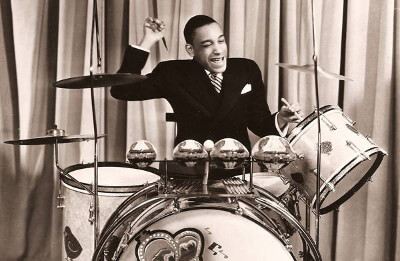PAS Hall of Fame:
William “Chick” Webb
(b. February 10, 1905 - d. June 16, 1939)
by James Robbins

There was a fine house band at the Savoy Ballroom during the 1930s. They weren’t widely known in the first half of the decade, but in 1935, after their leader discovered and hired the loser of an amateur singing contest (her name was Ella Fitzgerald), their fortunes began to change. 1 In 1936, their record “A little bit later on” (Decca 831) was one of Metronome’s records of the year. 2 In 1937, they got a regular radio spot on NBC, played successfully at a major downtown theater (Lowe’s State), and toppled none other than the Benny Goodman Orchestra in “battle of the bands.” 3 More records of the year followed in 1938 (including the novelty hit “A tisket, a-tasket,” Decca, 1840), 4 and the New York gigs became even more prestigious; they played at the Paramount, and, in December, became the first Black band to be hired at the Park Central Hotel. 5 This was, at last, a most successful band. Half a year later, on June 16, 1939, the leader of the band, William “Chick” Webb, died at the age of thirty of tuberculosis of the spine. 6 Without his leadership and strong, tasteful drumming, the band lost its spark; they broke up in 1941. 7
Web was “a crazy drummer” (Mary Lou Williamson), “the most luminous of all drum stars” (Gene Krupa); 8 in 1937, “the greatest drummer living today” (Dave Tough). 9 He started playing professionally at age 11 with the Jazzola band, in and around his hometown of Baltimore. He became friends with the guitar player of the Jazzola’s, John Trueheart, and they continued to play together throughout most of Webb’s short life, forming the heart of one of the best rhythm sections ever to propel a big band. The lift of that rhythm section is evoked by Webb’s own poignant definition of swing: “It’s like loving a gal, and having a fight, and then seeing her again.” 10
But it wasn’t only the powerful swing of the Webb-Trueheart combination that gained the loyalty of the fans at the Savoy (and their “happy feet,” as the band’s famous theme song has it). Webb was, according to Cootie Williams, “perhaps the greatest natural bandleader jazz has ever known…Any musician that worked with Chick…became a great musician.” 11 Although he was never a particularly good score reader, he had an ear and a memory which enabled him to pick out and correct mistakes in the often intricate arrangements played by the band. Edgar Sampson (who was responsible for many of those arrangements) recalled how, after a good night, Webb would draw attention to any unusually good solo improvised by one of his sidemen by singing it back from memory. 12
If he had a fault as a leader, it was that he was too trusting; he became an easy mark in the cutthroat music business. So for his first few years as a leader, in the late 1920s, he had to scuffle for work, and lost a number of sidemen during dry spells – sidemen such as Johnny Hodges and Cootie Williams. 13 Despite advice to the contrary, he refused to replace the “brilliant but unpredictable” Benny Carter; Carter quit the band and took half of the other members to start his own band. 14 But Webb persevered, despite bad luck. In the words of his one-time boss, Duke Ellington, he had “taken it on the chin for a good long time. Webb was never a quitter – and in the end got the success he was after.” 15
Chick Webb led a band noted as “the least appreciated band in the country.” 16 After his death, he was recognized as a “great man” 17 and one of the “immortals of jazz.” 18 Downbeat’s writer, providing the latter accolade, predicted that, “likeable and kindly, Chick and his talents long will be remembered by musicians.” 19 Happily, it was a prediction that is coming true; such musical excellence deserves to be honored.
End Notes
1 Barry Ulanov, “Cootie calls Chick greatest leader,” Metronome 57 (July, 1941): 46; Anon., “Immortals of jazz,” Down beat, 8 (Jan. 1, 1941): 10.
2 George T. Simon, Simon says: The sights and sound of the swing era 1935-155) (New Rochelle, N.Y.: Arlington House, 1971), p. 375.
3 Ulanov,, “Cootie calls Chick,” p. 46.
4 Simon, Simons says, pp. 377-78.
5 Ulanov, “Cootie calls Chick,” p. 47.
6 Ibid., p. 7. According to Charters and Kunstadt,, Webb died after an operation for a liver ailment (Samuels Charters and Leonard Kunstadt, Jazz: A history of the New York scene (Garden City, N.Y.: Doubleday, 1962), p. 260.
7 Charters and Kunstadt, Jazz, p. 260.
8 Nat Shapiro and Nat Hentoff, Hear me talkin’ to ya (New York 1955; reprint ed. Rinehart, Dover 1966), pp. 194-195.
9 Simon, Simon says, p. 443.
10 Ibid., p. 76.
11 Ulanov, “Cootie calls Chick,” p. 20.
12 Ibid., p. 46.
13. Ibid., p. 20.
14 Charters and Kunstadt, Jazz, p. 256.
15 Shapiro and Hentoff, Hear me talkin’ to ya, p. 195.
16 Simon, Simon says, p. 391.
17 Ulanov, “Cootie calls Chick,” p. 47.
18 Anon., “Immortals of Jazz,” p. 10.
19 Ibid., p. 10.
This article was published in January 1986, Percussive Notes V. 24, N. 2









